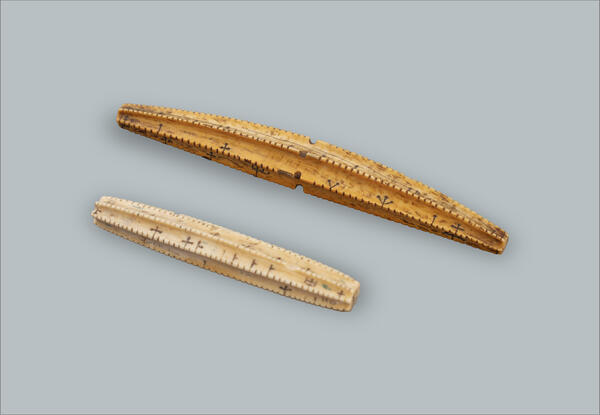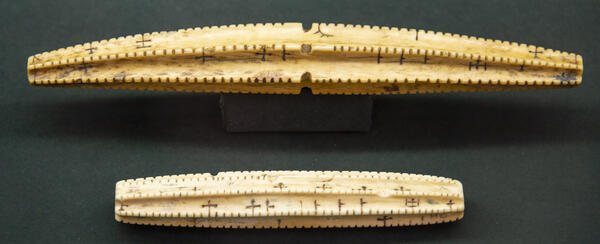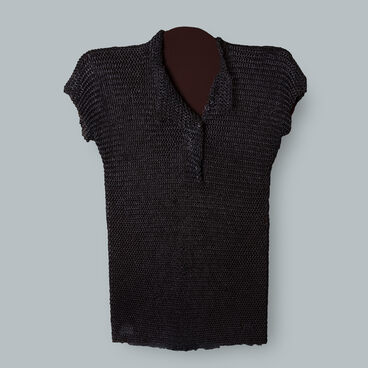A paskaal is a bone (made of mammoth tusk) or wooden hexagonal stick, 15–18 cm long, thinner around the edges and with a thickening in the middle. Each of the six sides of the calendar divides the month into two equal parts with a nail-shaped notch or line.
Like the Yakuts, the Dolgans referred to months as “moons” (bj), but the paskaal cannot be considered a “lunar calendar” in the usual sense — in terms of how time is reckoned. The twelve months of the year were divided in it by floating boundaries, which changed depending on climatic conditions and economic activities.
Every family had its own calendar, and the information it contained was only partly identical even among neighbors. The stick had various notches: simple ones — for weekdays and ornately shaped ones — for holidays.
Christian holidays and fasts were particularly marked (the similarity of the words “paskaal” and “Paskha” — the Russian word for Easter — is not a coincidence). Family members used them, for example, to understand when fishing and hunting were allowed and when they were not. The sequence of festivals can be compared with the European calendar.
Another type of marking was for family occasions: name days and birthdays.
Yet another type of notch was secret, unintelligible to the outsider. They were related to hunting and fishing secrets and were devised by specific people in specific places. For the same reason, the paskaal was hidden when outsiders approached.
The names of the Dolgan months, their main economic feature and their correspondence with the months of the European calendar:
1. Heen bja — the lake source month; fishing at lake source (December to January).
2. Dirig bja — the month of deep water; fishing in deep waters of lakes (January to February).
3. Kohor bja — the month of moving; with the onset of warmer days, people move from sedentary winter camps to light pole chums (February to March).
4. Sieneen bja — the burbot month; burbot ice fishing ends (March to April).
5. Taba emijdiir bja — the month (of increase) of udder of (pregnant) reindeer, i.e. female reindeer (April-May).
6. Taba tочyyr bja — the month of reindeer calving (May-June).
7. Uu keler bja — the month of floods (June to July).
8. Bdrdak bja — the mosquito month (July to August).
9. Irgekte bja — the gadfly month (August to September).
10. Ciekte bja — the month of (falling) of (larch) needles (September to October).
11. Atbbr bja — the month of the poroz; the rutting period of domestic studs (the poroz) in the reindeer herd (October to November).
12. Atbbr karaibbr bja — the month of “blackening” of the poroz (winter furring of the domestic poroz) (November to December).
Like the Yakuts, the Dolgans referred to months as “moons” (bj), but the paskaal cannot be considered a “lunar calendar” in the usual sense — in terms of how time is reckoned. The twelve months of the year were divided in it by floating boundaries, which changed depending on climatic conditions and economic activities.
Every family had its own calendar, and the information it contained was only partly identical even among neighbors. The stick had various notches: simple ones — for weekdays and ornately shaped ones — for holidays.
Christian holidays and fasts were particularly marked (the similarity of the words “paskaal” and “Paskha” — the Russian word for Easter — is not a coincidence). Family members used them, for example, to understand when fishing and hunting were allowed and when they were not. The sequence of festivals can be compared with the European calendar.
Another type of marking was for family occasions: name days and birthdays.
Yet another type of notch was secret, unintelligible to the outsider. They were related to hunting and fishing secrets and were devised by specific people in specific places. For the same reason, the paskaal was hidden when outsiders approached.
The names of the Dolgan months, their main economic feature and their correspondence with the months of the European calendar:
1. Heen bja — the lake source month; fishing at lake source (December to January).
2. Dirig bja — the month of deep water; fishing in deep waters of lakes (January to February).
3. Kohor bja — the month of moving; with the onset of warmer days, people move from sedentary winter camps to light pole chums (February to March).
4. Sieneen bja — the burbot month; burbot ice fishing ends (March to April).
5. Taba emijdiir bja — the month (of increase) of udder of (pregnant) reindeer, i.e. female reindeer (April-May).
6. Taba tочyyr bja — the month of reindeer calving (May-June).
7. Uu keler bja — the month of floods (June to July).
8. Bdrdak bja — the mosquito month (July to August).
9. Irgekte bja — the gadfly month (August to September).
10. Ciekte bja — the month of (falling) of (larch) needles (September to October).
11. Atbbr bja — the month of the poroz; the rutting period of domestic studs (the poroz) in the reindeer herd (October to November).
12. Atbbr karaibbr bja — the month of “blackening” of the poroz (winter furring of the domestic poroz) (November to December).




